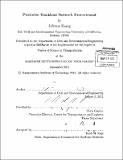Piecewise truckload network procurement
Author(s)
Huang, Jefferson
DownloadFull printable version (6.895Mb)
Other Contributors
Massachusetts Institute of Technology. Dept. of Civil and Environmental Engineering.
Advisor
Chris Caplice.
Terms of use
Metadata
Show full item recordAbstract
Faced with procuring transportation over its freight network, a shipper can either bid out all of its lanes at once, or somehow divide up the network and bid it out in pieces. For large shippers, practical concerns such as attendant manpower requirements and exposure to financial/operational risks can make the former undesirable or even infeasible. Such a shipper therefore needs to determine how to best allocate the lanes in its freight network to different bids to be run at different times. This thesis addresses this allocation problem. Two related approaches are presented. The first focuses on explicitly preserving the synergies that arise in truckload network operations while attempting to balance the sizes of each bid, and is framed as a graph partitioning problem. The second treats lanes as independent entities and frames network allocation as a bin-packing problem, with constraints that attempt to achieve both balance and, implicitly, synergy preservation. These two approaches are illustrated and evaluated using a small subnetwork consisting of lanes from a large shipper. While the graph partitioning approach works in theory, the as yet unresolved question of what constitutes a "correct" synergy definition for network partitioning purposes, and the practical significance of the constraints considered in the bin-packing approach, make this second approach more attractive. The development of a lane allocation model that can explicitly consider inter-lane synergies as well as the kinds of constraints addressed in the second approach is left for future work.
Description
Thesis (S.M.)--Massachusetts Institute of Technology, Dept. of Civil and Environmental Engineering, 2011. Cataloged from PDF version of thesis. Includes bibliographical references (p. 107-110).
Date issued
2011Department
Massachusetts Institute of Technology. Department of Civil and Environmental EngineeringPublisher
Massachusetts Institute of Technology
Keywords
Civil and Environmental Engineering.